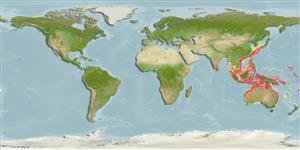Environment: milieu / climate zone / depth range / distribution range
Ecologie
marien demersaal; diepte 50 - 150 m (Ref. 90102). Tropical
Indo-West Pacific: Nicobar Islands and throughout most of the Indo-Australian Archipelago, north to southern Japan (Ref. 9774).
Grootte / Gewicht / Leeftijd
Maturity: Lm ? range ? - ? cm
Max length : 40.0 cm SL mannelijk / geslacht onbekend; (Ref. 9774); common length : 25.0 cm SL mannelijk / geslacht onbekend; (Ref. 9774)
Dorsale stekels (totaal) : 0; Dorsale zachte stralen (totaal) : 72 - 78; Anale stekels: 0; Anale zachte stralen: 56 - 63; Wervels: 36. Above and below lateral line with 1 or 2 pairs of distinct double ocelli. Many darker rings and spots scattered on body and median fins. Body ovoid, its depth 2.2 to 2.4 times in SL. Head length 3.4 to 3.7 times in SL. Upper profile of head strongly notched in front of upper eye. A line connecting base of first dorsal-fin ray and posterior nostril on eyed side crosses maxilla. Snout protruded, its length 1 to 1.3 times of eye diameter. Eye diameter 4.3 to 5 times in head length. Maxilla extending to below or beyond middle of lower eye. Teeth in both jaws small, without strong canines (Ref 9774). Gill rakers palmate, as broad as long. Two to four large double ocelli on body (Ref. 559).
Inhabits muddy and sandy bottoms of the continental shelves. Feeds on fish (Ref. 30463, 48637) and small benthic animals. Marketed fresh (Ref. 9774).
Levenscyclus en paargedrag
Maturiteit | Voortplanting | Paaien | Eieren | Fecunditeit | Larven
Distinct pairing (Ref. 205).
Masuda, H., K. Amaoka, C. Araga, T. Uyeno and T. Yoshino, 1984. The fishes of the Japanese Archipelago. Vol. 1. Tokai University Press, Tokyo, Japan. 437 p. (text). (Ref. 559)
Status op de Rode Lijst van het IUCN (Ref. 130435: Version 2024-2)
Gevaar voor de mens
Harmless
Gebruik door de mens
Visserij: commercieel
Tools
Speciale rapporten
Download XML
Internetbronnen
Estimates based on models
Preferred temperature (Ref.
123201): 20.5 - 28, mean 25.7 °C (based on 405 cells).
Fylogenetische diversiteitsindex (Ref.
82804): PD
50 = 0.5000 [Uniqueness, from 0.5 = low to 2.0 = high].
Bayesian length-weight: a=0.00724 (0.00338 - 0.01553), b=3.17 (3.00 - 3.34), in cm total length, based on LWR estimates for this Genus-body shape (Ref.
93245).
Trofisch niveau (Ref.
69278): 4.2 ±0.73 se; based on food items.
Weerstandsvermogen (Ref.
120179): Gemiddeld, minimale populatieverdubbelingstijd 1,4-4,4 jaar (Preliminary K or Fecundity.).
Fishing Vulnerability (Ref.
59153): Moderate vulnerability (39 of 100).
